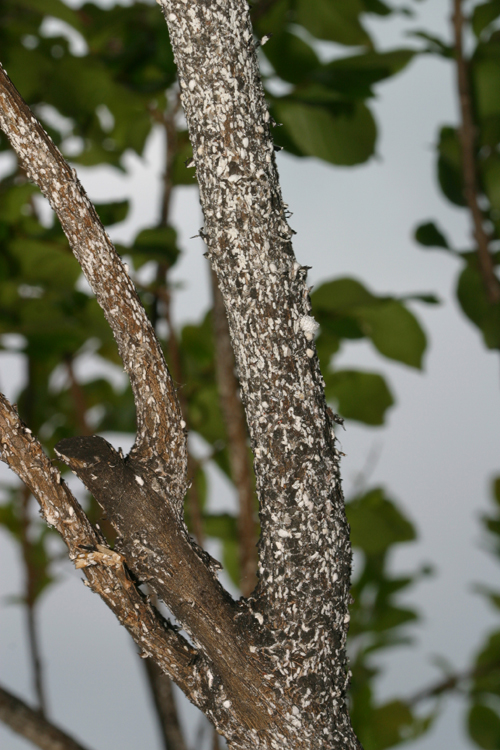
The crapemyrtle bark scale can be controlled with two over-the-counter insecticides; but the names and availability of these products are constantly changing.
In my Master Gardener classes one of the most confusing aspects of learning insecticides is common vs. trade names. It’s actually not too different from retail and common names of over-the-counter drugs. Tylenol® is one well known trade name for the active ingredient with the common name acetaminophen. There are many other trade names for products that contain the same active ingredient, including Anacin® and Excedrin®, to name just two.
In the same way, insecticides have common and trade names. Acephate is the common name for an insecticide often labeled Orthene®. Carbaryl is the common name for an insecticide often sold under the Sevin® trade name.
Most extension fact sheets and websites refer to pesticides by their common names. We do this so as to not imply endorsement of any particular brand, and because there are often too many trade names to list them all. Unfortunately, few people take the time to read the common names in fine print on the active ingredients list of labels. Instead, most of us look for the big trade name splashed in colorful fonts across the front of the neatly shelved bottles at the garden center.
Our dependence on trade names is a little dangerous when it comes to selecting a product that we know will work consistently, and do just what we want it to do. This came home to me this morning when a caller was having difficulty finding two insecticides that we are recommending for control of the new crapemyrtle bark scale (CMBS) pest affecting many landscapes.
Our recommended insecticides for suppression of this scale pest include imidacloprid and dinotefuran. These are two systemic insecticides in the neonicotinoid class of insecticides. Currently they are the most effective insecticides for CMBS that we have for the consumer market. They are best applied as a drench to the soil around infested trees. The past few years they have been sold under the trade names of Bayer Advanced Garden® Tree & Shrub Insect Control and Greenlight Safari®. No longer.
If you are looking for either of these active ingredients today, you may have to go online, and will likely be sold under different trade names. For example, the former Bayer Advanced Garden® product is no longer listed on the Bayer website, except as a combination formulation with a fertilizer. It is now called Bayer Advanced Garden® 12 Month Tree and Shrub Protect and Feed, and includes another active ingredient called clothianidin (a related product that also controls scale). You can still find imidacloprid in its original version under different trade names such as Monterey Once-a-Year Insect Control®, Merit® and Prime Source Imidacloprid 2F Select™, among other products online.
The retail formulator Greenlight has recently been bought by Scotts’ Brands, and dinotefuran is no longer sold by that manufacturer. This means that consumers may have to look harder online for formulations with this active ingredient. A few that I found after a quick search included Venom Insecticide, Zylam, and Safari 20 SG. Unfortunately, the problem with these formulations is that they are in larger containers that may cost over $100, a price that most consumers will balk at.
Part of the problem is that many modern insecticides are increasingly specialized. This leads manufacturers to chase larger markets by creating combo products that include ingredients that might not be needed by all consumers (such as combination fertilizer+insecticide formulations). It can also lead to manufacturers dropping useful insecticides because they don’t kill enough different kinds of pests to reach a big customer base.
The growth of online pesticide retailers may help out the consumer looking for less common insecticides. I find myself going to the online DIY pest control shops frequently looking for information about retail availability of insecticides, and for copies of labels. Though I am a little wary about insecticides being sold online without the buyer having the chance to first talk to a knowledgeable sales person, I applaud most of these online retailers for making product labels accessible to the shopper. I have a harder time finding labels with some manufacturer websites than I do with most of the DIY sites.
If you do choose to purchase an insecticide online, please read the label first. The label will tell you whether you can use the pesticide in the site you have in mind, whether it will control your pest, and what the environmental and health safety issues are. Also make sure that the product can be used in your state. If you can’t find a label on the site, it might be best to shop elsewhere.
If I had my way, trade names for insecticides would be short and easy to remember, and wouldn’t change every year. But I guess that’s part of the marketing game, and it probably won’t go away tomorrow. As it is, all the changes are enough to give anyone a headache. I think I’ll go take a Tylenol®.